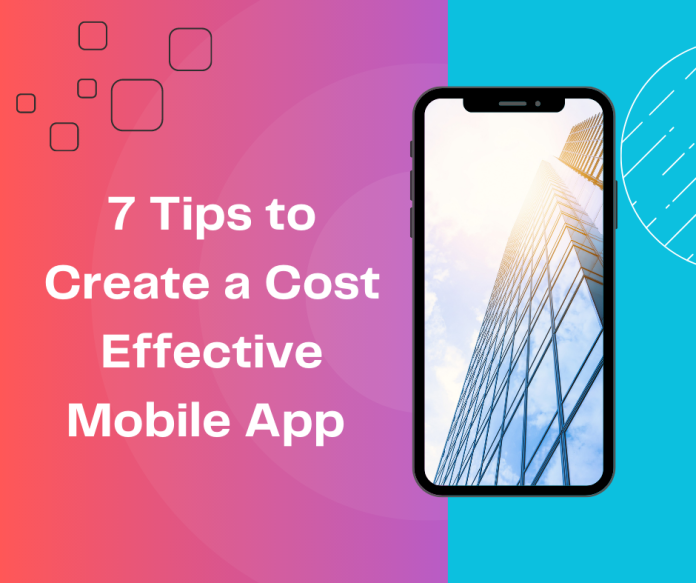With a rapid increase in smartphone usage, the mobile application market is rapidly expanding globally. Today, mobile apps are no longer just a way of providing information and entertainment but act as an add-on for a company’s brand.
Developing a mobile application sounds quite expensive. Most people believe that developing a high-quality mobile app costs a huge amount of money and their limited budget for the application will suffer.
However, that’s not the case. The mobile app development companies sometimes come out with wonderful apps on even low budgets. Many companies prefer to build successful mobile applications with a strict budget.
There are certain tips that you can adapt to cut down the app making cost without even comprising its quality:
1. Do some basic research:
The expenses for the mobile application development, on the whole, do not end with its launch – they go well and beyond when you find bugs that are required to be corrected in the upcoming version of the app. But if initial research is carried out on different aspects, there won’t be the need to modify the application later on, which will result in reduced costs.
To do some basic research, consider the following points:
- Your company’s background: App developers in a custom app development company should have a clear idea of the company, location, and most importantly the business values.
- The general idea of the app: Have a rough idea in your mind of the application you are planning to build including its functionality, target audience, and why your audience needs this application so you can plan its features accordingly.
- The sequence that the app will follow: Recognise what’s the sequence that the app will follow. It helps the developers to get the overall picture that the user will see through the app.
- Deadline and budget: Plan the budget and time limitations that you can provide to the developers.
2. Identify the right approach:
The mobile application development approach should include the time and budget limitations of a client. There are three types of approaches to creating a mobile app:
- Native: A native app is based on a specific platform, requires more time, and highly skilled developers. Although native apps are expensive and time-consuming, they provide the best user experiences among all the approaches.
- Hybrid: Hybrid approach is a combination of both native and web approaches. Compared to PWAs, hybrid apps are a bit costly. In this type of mobile application, the web code is integrated with the native language to create exclusive features and access native APIs that are not available in JavaScript yet.
3. Build an MVP:
If the main features of the application cost more than the ideal budget, consider building an MVP (Minimal Viable Product) instead of developing a complete functionality app from the scratch. MVP is important in business app development because of its cost-efficient properties. An MVP will allow you to:
- Collect valuable feedback from early users
- Approve your idea with actual users
- Analyse audience needs and demands
- Pitch investors for funding to develop a fully functional business app
It’s best to start with an app with 2-3 important features and test the app in the market before investing more money to make a mobile app.
4. Select cross-platform app development:
The current trend in mobile app development is creating cross-platform applications where the code is written once and can be deployed across all platforms, including iOS and Android.
This helps in saving a lot of time and reducing the development of app costs as you don’t have to create different apps for different mobile operating systems. It results in increased ROI on development and reduces the time on app marketing.
5. Choose open-source frameworks:
Creating an app from the beginning is extremely expensive and time-consuming. Your main goal should only be on the features, specifications, and content of the application. So to reduce costs, build a mobile app using an open-source framework that already has some basic functionalities of an app. You can also test and try templates along with other tools using a framework.
6. Hire the right outsourcing agency:
Most app developers in India differ in both their experience and the quote offered. It is important to balance these two important points. Because selecting an agency with low pricing and less experience can affect the quality of an application.
Always outsource a mobile app development agency that knows to handle every aspect of the application itself, including planning, designing, developing, content writing and marketing, launch and maintenance, etc. instead of just choosing the one that deals with a part of the project as it adds the extreme cost of an app.
7. Select the right app development pricing model:
When conducting some basic research, decide whether you want to pay hourly rates or a fixed price to some outsourcing agency. Availing of mobile app development services with fixed prices seems more reasonable as you have a limited budget.
However, with a fixed-price app model, there won’t be any chances to make any modifications later on unless you pay an extra penny for making those modifications.
Some mobile app development firm provides another app development pricing model for businesses that have limited budgets. These companies suggest where you can reduce costs and what features you shouldn’t mention, so you can have a quality mobile application with a limited app price.
Some other tips you should look for:
- Reuse content: If your business requires more than one application, reuse existing content, as it saves time and reduces content development costs.
- Avoid push notifications, if not necessary: Removing the push notification feature can reduce overall expenses by around 20%. It is not an essential feature that the app cannot run without – unless your business model requires it. As a small business owner or a startup, you can save costs by leaving out this feature initially, at least.
- Perform regular testing: Test the app regularly to ensure that all features of the application are working as expected and are providing users with a rich experience.
There are several functions in the app that are linked to one another, and making modifications in one of them after project completion can result in breaking up the flow and increasing the cost of mobile app development.
- Third-party services: If you want to include third-party services such as in-app chat, DNS services, and collaborative tools, you may have to give out some funds. Discuss with the mobile app development service provider to figure out how much you should spend on third-party services.
Why Choose Outsourcing for App Development?
Outsourcing an app development company means hiring a mobile app development company for building your business mobile application. There are some outsourcing models that enterprises prefer, but mostly they prefer local and offshore outsourcing.
Offshore basically refers to choosing a development partner from another country, and this model is mostly preferred in international countries such as Canada and US. They outsource agencies in developing nations where development costs are lower, such as Mexico, India, and Ukraine. Additionally, besides charging less, they also provide quality work in very less time.
Although in-house app development costs mean more control over the designing and development stage, it involves more expenses than outsourcing app development. The mobile application development cost can vary depending on project requirements such as the complexity and features of the application.
The cost of making an in-house mobile app is around a few hundred thousand dollars to half a million dollars. On the other hand, hiring an outsourcing agency for the app development process reduces the cost, ranging from a few thousand dollars to tens of thousands of dollars.
However, also remember that outsourcing app development firms also include some risks such as meeting issues, communication barriers, quality control, project delays, and many more. Therefore, it’s essential that you choose an experienced and reliable outsourcing mobile app company and establish a clear communication channel for the complete success of your project.
Mobile app development can be costly worldwide for small businesses. But if done correctly, you can avoid unexpected expenses and launch your app faster and cheaper to the app store.
Final Thoughts
You can’t deny the fact that creating a mobile app for the very first time can be quite overwhelming. While developing an app with a limited budget, make sure you don’t leave out any main feature that can affect the quality of an application.
It is best that you start with basic features that are important initially and later add on more features and functionalities with newer versions. Collect feedback from users and use that feedback to improve the quality and functionalities of the application to give your audience a rich user experience.
By following the above-mentioned tips, you can easily create a cost-effective mobile application that delivers value to your users and helps your business succeed in 2023 and beyond. Remember, creating a mobile app is a continuous process, and it’s important to improve and update your application on a timely basis to stay ahead of the competitors and give them a competitive edge.
Author Bio
 Husain Saify is the founder and CEO of Hackerkernel, a software development company offering dedicated remote developers. He enjoys writing and sharing engaging blog topics and articles related to mobile and web apps.
Husain Saify is the founder and CEO of Hackerkernel, a software development company offering dedicated remote developers. He enjoys writing and sharing engaging blog topics and articles related to mobile and web apps.





